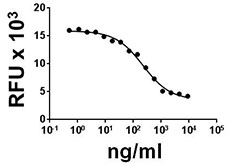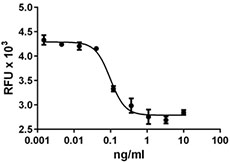- Regulatory Status
- RUO
- Other Names
- Amphiregulin (AR), AREG, Schwannoma-derived growth factor (SDGF), Colorectum cell-derived growth factor (CRDGF).
- Ave. Rating
- Submit a Review
- Product Citations
- publications

-

BALB/3T3 cell proliferation induced by mouse amphiregulin. -

Recombinant mouse Amphiregulin induces the proliferation of mouse fibroblasts Balb/3T3 cell line in a dose dependent manner. BioLegend’s protein was compared side-by-side to the leading competitor’s equivalent product.
| Cat # | Size | Price | Quantity Check Availability | Save | ||
|---|---|---|---|---|---|---|
| 554102 | 10 µg | 72€ | ||||
| 554104 | 25 µg | 132€ | ||||
Amphiregulin was initially identified in the conditioned medium of human mammary gland MCF-7 cells treated with TPA. The mouse gene was cloned from the androgen-dependent SC2G cell line derived from Shionogi mouse mammary carcinoma SC115. It belongs to the EGF family of proteins that includes EGF, TGF-α, heparin-binding EGF like-growth factor (HB-EGF), epigen, epiregulin, and betacellulin. Mouse amphiregulin is derived from a 248 amino acid transmembrane precursor, and it has 66% identity to the human protein. All the EGF family members are synthesized as type I membrane protein precursors, which can undergo proteolytic cleavage at the plasma membrane to release a mature soluble ectodomain. ADAM17 (TACE) has an important role in ectodomain shedding of amphiregulin, TNF-α, and HB-EGF. This cleavage is a key step in the control of ligand availability and receptor activation, and it is stimulated by physiological and pharmacological agonists, including TPA, calcium ionophores, GPCR ligands, cytokines, and growth factors. Amphiregulin is a paracrine regulator of estrogen action during ductal morphogenesis (mammary gland development), and it has been associated with breast cancer initiation and progression. Amphiregulin is elevated in psoriatic lesional skin, gastrointestinal carcinomas, colorectal cancer, and hepatocelular carcinoma tissues. In addition, FOXP3+ Tregs express EGFR under inflammatory conditions, and amphiregulin enhances regulatory T cell-suppressive function in vitro and in vivo in a colitis and tumor vaccination model.
Product DetailsProduct Details
- Source
- Mouse Amphiregulin, amino acids (Ser94-Lys191) (Accession# NM_009704), was expressed in E. coli.
- Molecular Mass
- The 98 amino acid recombinant protein has a predicted molecular mass of approximately 11.3 kD. The DTT-reduced and non-reduced protein migrate at approximately 16 kD and by SDS-PAGE. The N-terminal amino acid is Ser.
- Purity
- >95%, as determined by Coomassie stained SDS-PAGE.
- Formulation
- 0.22 µm filtered protein solution is in PBS, pH 7.2.
- Endotoxin Level
- Less than 0.01 ng per µg cytokine as determined by the LAL method.
- Storage & Handling
- Unopened vial can be stored between 2°C and 8°C for up to 2 weeks, at -20°C for up to six months, or at -70°C or colder until the expiration date. For maximum results, quick spin vial prior to opening. The protein can be aliquoted and stored at -20°C or colder. Stock solutions can also be prepared at 50 - 100 µg/mL in appropriate sterile buffer, carrier protein such as 0.2 - 1% BSA or HSA can be added when preparing the stock solution. Aliquots can be stored between 2°C and 8°C for up to one week and stored at -20°C or colder for up to 3 months. Avoid repeated freeze/thaw cycles.
- Activity
- ED50 = 0.04 - 0.2 µg/ml, corresponding to a specific activity of 0.5 - 2.5 x 104 units/mg, as determined by induction of BALB/3T3 cell proliferation.
- Application
-
Bioassay
- Application Notes
-
BioLegend carrier-free recombinant proteins provided in liquid format are shipped on blue-ice. Our comparison testing data indicates that when handled and stored as recommended, the liquid format has equal or better stability and shelf-life compared to commercially available lyophilized proteins after reconstitution. Our liquid proteins are verified in-house to maintain activity after shipping on blue ice and are backed by our 100% satisfaction guarantee. If you have any concerns, contact us at tech@biolegend.com.
- Product Citations
-
Antigen Details
- Distribution
-
Fibroblasts, epithelial cells, carcinoma cell lines, T cell subsets, naive and memory CD4 and CD8 T cells, Th1 and Th2 cells, mast cells, eosinophils, and basophils.
- Function
- Amphiregulin induces proliferation of fibroblasts, keratinocytes, and normal and malignant epithelial cells. It acts in normal development, organogenesis, and tumorigenesis. Ampiregulin release is mediated by IL-1β in fibroblast-like synoviocytes in rheumatoid arthritis patients. It is induced by IL-3 and IL-5 in basophils and eosinophils, respectively.
- Interaction
- Keratinocytes, epithelial cells, fibroblasts, carcinoma cells, and FOXP3 Tregs.
- Ligand/Receptor
- EGFR (HER1)
- Cell Type
- Embryonic Stem Cells, Hematopoietic stem and progenitors, Mesenchymal Stem Cells, Neural Stem Cells
- Biology Area
- Stem Cells
- Molecular Family
- Cytokines/Chemokines, Growth Factors
- Antigen References
-
1. Plowman GD. 1990. Mol. Cell Biol. 10:1969.
2. Sonoda H, et al. 1992. Biochem. Biophys. Res. Commun. 185:103.
3. Le Gall SM, et al. 2003. J. Biol. Chem. 278:45255.
4. Berasain C, et al. 2007. Cancer Letters 254:30.
5. Busser B, et al. 2011. Biochim. Biophys. Acta. 2:119.
6. Latasa MU, et al. 2012. PLoS One 7:e52711.
7. Qi Y, et al. 2012. PLoS One 7:e39072.
8. Zaiss DM, et al. 2013. Immunity 38:275.
9. Taira N, et al. 2014. Proc. Natl. Acad. Sci. 111:717. - Gene ID
- 11839 View all products for this Gene ID
- UniProt
- View information about Amphiregulin on UniProt.org
Related FAQs
- Why choose BioLegend recombinant proteins?
-
• Each lot of product is quality-tested for bioactivity as indicated on the data sheet.
• Greater than 95% Purity or higher, tested on every lot of product.
• 100% Satisfaction Guarantee for quality performance, stability, and consistency.
• Ready-to-use liquid format saves time and reduces challenges associated with reconstitution.
• Bulk and customization available. Contact us.
• Learn more about our Recombinant Proteins. - How does the activity of your recombinant proteins compare to competitors?
-
We quality control each and every lot of recombinant protein. Not only do we check its bioactivity, but we also compare it against other commercially available recombinant proteins. We make sure each recombinant protein’s activity is at least as good as or better than the competition’s. In order to provide you with the best possible product, we ensure that our testing process is rigorous and thorough. If you’re curious and eager to make the switch to BioLegend recombinants, contact your sales representative today!
- What is the specific activity or ED50 of my recombinant protein?
-
The specific activity range of the protein is indicated on the product datasheets. Because the exact activity values on a per unit basis can largely fluctuate depending on a number of factors, including the nature of the assay, cell density, age of cells/passage number, culture media used, and end user technique, the specific activity is best defined as a range and we guarantee the specific activity of all our lots will be within the range indicated on the datasheet. Please note this only applies to recombinants labeled for use in bioassays. ELISA standard recombinant proteins are not recommended for bioassay usage as they are not tested for these applications.
- Have your recombinants been tested for stability?
-
Our testing shows that the recombinant proteins are able to withstand room temperature for a week without losing activity. In addition the recombinant proteins were also found to withstand four cycles of freeze and thaw without losing activity.
- Does specific activity of a recombinant protein vary between lots?
-
Specific activity will vary for each lot and for the type of experiment that is done to validate it, but all passed lots will have activity within the established ED50 range for the product and we guarantee that our products will have lot-to-lot consistency. Please conduct an experiment-specific validation to find the optimal ED50 for your system.
- How do you convert activity as an ED50 in ng/ml to a specific activity in Units/mg?
-
Use formula Specific activity (Units/mg) = 10^6/ ED50 (ng/mL)
 Login / Register
Login / Register 














Follow Us